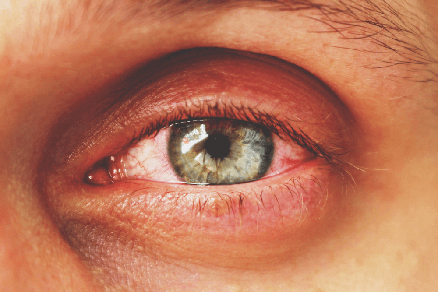Lyme disease is an infection transmitted by ticksthat can cause symptoms in many body systems, including the eyes. Eye problems are uncommon side effects of Lyme disease that can occur in the early or late stages of the disease. These ocular symptoms of Lyme disease take many different forms.
Conjunctivitis

Redness and discharge due to inflammation of the conjunctiva may occur early in Lyme disease. The conjunctiva or mucosa of the eyeball and lower eyelid appears pinkish, with tiny reddened blood vessels visible. Pus may be present. This type of conjunctivitis is not contagious and goes away on its own.
Uveitis
An inflammation of the uvea, the middle part of the eye, is called uveitis. The uvea consists of :
- The iris, the colored part of the eye;
- The ciliary body, which produces the fluid ;
- The choroid, the layer under the retina.
Lyme disease can causeintermediate uveitis, also called pars planitis, which affects the area behind the iris. Pars planitis is often painless.
The main symptoms are an increase in floaters - black dots or lines that move - and vision loss.
The main treatment used for uveitis is steroid eye drops, which reduces inflammation. Treatment may takeseveral months, as the steroids must be reduced slowly or rebound effects will occur. Dilating drops to the pupil can be used to prevent the iris from sticking to the lens. This can happen ifthe iris is scarred. This can cause permanent vision loss.
Optic neuritis
The optic nerve carries impulses from the retina to the brain. Optic neuritis is an inflammation of the fibers that cover the optic nerve. Lyme disease can cause optic neuritis. Symptoms include eye pain, inability to see color and vision loss. Steroids are administered intravenously and as eye drops to treat optic nerve neuritis.
Keratitis
Keratitis, or inflammation of the cornea, can be one of the eye symptoms of Lyme disease. Keratitis can cause eye pain, sensitivity to light, tearing, and blurred vision. The eye may appear opaque or covered with a white haze. Prednisone, a steroid, is administered as a of drops for the eyes or orally for two to six months for more severe infections.
Retinal vasculitis
Inflammation of retinal blood vessels, also known asretinal vasculitis, can occur as a complication of Lyme disease. The most common symptoms of retinal vasculitis are progressive and painless vision loss. Treatment depends on the presentation of the disease. But this usually includes high-dose steroids and may include an ocular steroid injection.Laser can be used if many small hemorrhages occur in eyes.
Retinal vein occlusion
Lyme disease is sometimes associated with retinal vein branch occlusion(RVO), a blockage in retinal veins. OBVR can cause loss of vision in the area where the blockage is located. There is no pain associated with an OBVR, butvision loss occurs if the blockage causes swelling of the macula. Treatment is donewith laser if the blockage is far from the macula. Or an intravitreal steroid injection if swelling occurs in the macula.
The cause and main symptoms of Lyme disease
Lyme diseaseis caused by a type of bacteria (Borrelia) that is transmitted to humans bythe bite of an infected blacklegged tick.
Symptoms may appear days after exposure, or even months or years after first contact.
The chances of getting Lyme disease depend on the type of tick and how long it has been attached to the skin. Generally, the tick must be attached to the skin more than 36 hours to spread the bacteria.
The first symptoms of Lyme disease include.
- Headaches,
- The fever,
- Fatigue,
- Muscle and joint pain
- Chills and swollen lymph nodes
A high number of infected people will develop a bullseye rash (called erythema migrans). This occurs at the site ofthe tick bite. This rash may get bigger and is usually not itchy or painful.
Lyme disease and light sensitivity
Some people have persistent symptoms that may include sensitivity to light and other vision-related complications.
Other eye symptoms of Lyme disease
Somevision problems, usually associated with chronic Lyme disease, can occur at any stage of the disease. In fact, one study showed that nearly 40% of pediatric patients with chronic symptoms ofLyme disease have ocular symptoms. These vision-related problems include:
- Eye pain or inflammation.
- Double vision (diplopia).
- Blurred vision or reduced concentration.
- Infections of the retina
Photophobia, or painful sensitivity to light, is another symptom that is certainly felt in the eyes. It also represents a more serious neurological problem.
Light sensitivity in Lyme disease
Statistically, light sensitivity can be rare in the early stages ofLyme disease, affecting between 5 and 16% of patients. However, the total impact of this painful symptom may be significantly underestimated. In fact, some researchers have recognized that up to 70% of patients with Lyme disease report photophobia.
The cause of light sensitivity in Lyme disease is not fully understood. But it could be related to symptoms of meningitis that occur in the early stages and/or to impaired brain function due to encephalopathy.
In addition, many patients have reported having to endure a variety of symptoms oflight sensitivity beyond their inability to tolerate bright light. This can include seeing halos, shadows, and episodes of fragmented vision. There is also a particular fuss about fluorescent lamps. This can lead to dizziness and even feelings of anxiety.
Sources:
https://www.em-consulte.com/en/article/687158
http://www.maladie-lyme-traitements.com/symptocircmes.html